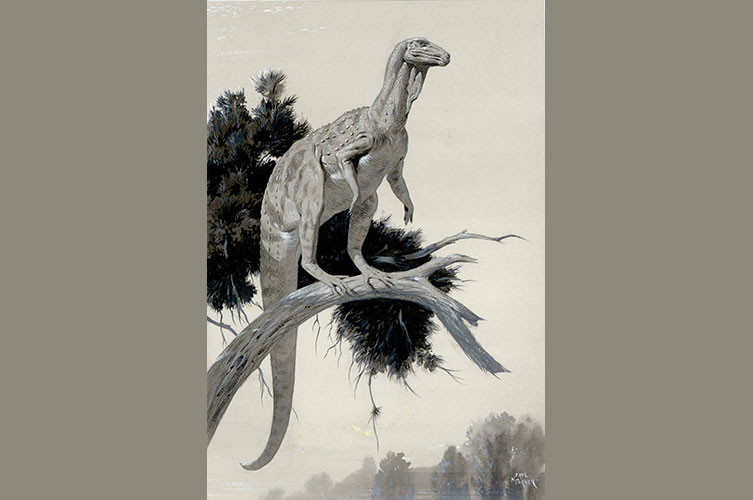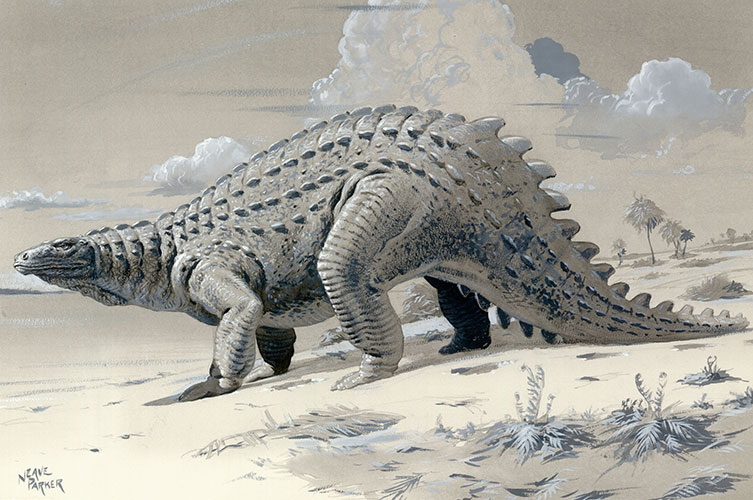The following dinosaur reconstructions were published in the 1960s in Museum guides.
Fossil evidence and investigations from the past 50 years have revealed some scientific inaccuracies. Can you spot what's wrong?

We now know Megalosaurus didn't have the head shape or short neck depicted in this reconstruction by Neave Parker from about 1960, but it is otherwise a surprisingly modern pose. Dinosaurs of this enormous size were previously thought to manoeuvre themselves on four legs.
The following dinosaur reconstructions were published in the 1960s in Museum guides.
Fossil evidence and investigations from the past 50 years have revealed some scientific inaccuracies. Can you spot what's wrong?
Created by the talented artist Neave Parker, based on fossil remains and the scientific expertise of palaeontologist William Elgin Swinton, the drawings stimulated popular interest in prehistoric life.
Parker's reconstructions were initially believed to be accurate. But as our scientific knowledge of the biology, morphology and behaviour of these dinosaurs has increased, their perceived appearance has changed.
Palaeoart images of dinosaurs are only ever as accurate as the fossil evidence available.
Despite the anatomical errors and other inaccuracies, Parker's illustrations are so beautiful and detailed that they remain favourites among dinosaur fans and experts alike.

Not only do palaeoartists have to reconstruct a dinosaur's appearance, they also need to understand how it would have stood and moved.
Here, Parker has positioned Iguanodon standing upright in a kangaroo-like pose. However, we now know that this dinosaur walked on all fours. The animal's spine would have been horizontal and the tail would have lifted off the ground.
Modern reconstructions are also much slimmer and lack the big throat pouch.

The eagle-eyed among you may spot an apparent fifth limb in Parker's depiction of Cetiosaurus.
Cetiosaurus was the first sauropod dinosaur to be discovered, although it wasn't initially recognised as such. Fossilised remains were unearthed in England and described by Richard Owen in 1842.
Parker shows Cetiosaurus as a semi-aquatic dinosaur. Although its long neck and tail are correctly drawn here, scientists now believe that, like other sauropods such as Diplodocus and Brachiosaurus, Cetiosaurus lived on land and held its tail in the air, rather than dragging it along the floor.
Many scientists in the nineteenth and early twentieth centuries considered sauropods to be much too large to fully support their weight on land and so showed them at least partially submerged in water. However, studies have since shown that their air-filled bones and small feet would not have been suited to a life in water.

Swinton believed Hypsilophodon could climb with ease and probably lived in trees. Parker reflects this in his illustration.
Following recent studies of the dinosaur's musculo-skeletal structure, this opinion is now universally regarded as incorrect. Hypsilophodon is now known to have used its two hind legs to run quickly on the ground.

The armour-plated Scelidosaurus is one of the best-known dinosaurs of the British Isles. A more complete representation of its skeleton has been unearthed than any other.
Although Parker included some armour in his reconstruction, Scelidosaurus also had armour extending onto its head and legs.
Additionally, the dinosaur's tail and the trunk of its body should be longer.

Parker based his creative reconstruction of Scleromochlus on a partial skeleton found in Scotland. At the time Swinton thought it was a theropod dinosaur, like Tyrannosaurus rex.
However, although this extinct animal roamed the Earth 200 million years ago, Scleromochlus was not a dinosaur. It is now thought to be closely related to the flying reptiles, pterosaurs.

Find out what Museum scientists are revealing about how dinosaurs looked, lived and behaved.
Don't miss a thing
Receive email updates about our news, science, exhibitions, events, products, services and fundraising activities. We may occasionally include third-party content from our corporate partners and other museums. We will not share your personal details with these third parties. You must be over the age of 13. Privacy notice.
Follow us on social media